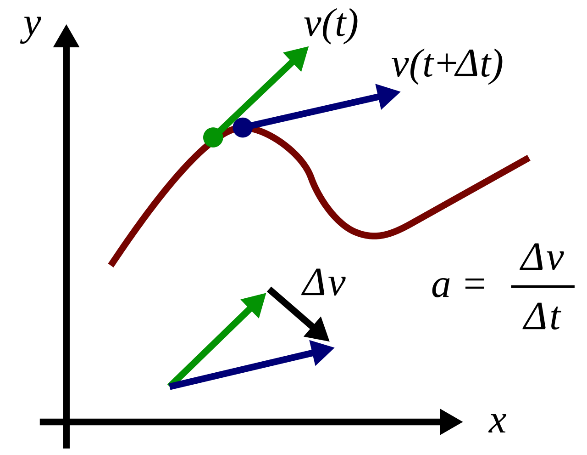Acceleration is an example of a vector quantity i.e. “it comprises of both direction and magnitude”. The direction of an object’s acceleration is oriented towards the resultant force’s direction on the object. Mechanics defines acceleration as “The rate of variation of velocity with respect to time.”
According to Newton’s second law of motion, acceleration is given by the ratio of the net force acting over an object to the mass of the object. In other words, acceleration is also termed as the rate of change of velocity with respect to time i.e. dv/dt. The unit of acceleration is meter per second squared based on the standard international (SI) system.
We know that both force and velocity are vector quantities and both mass and time are scalar quantities. “When we divide a vector quantity by a scalar quantity it results in a vector quantity.” Hence mathematically, we can say that by the virtue of this property acceleration is also a vector quantity i.e. it has both direction and magnitude.
Physically, the force acting on an object can make it move or speed up towards the direction in which the resultant force lies. This means that the object starts to accelerate towards that direction upon the action of the resultant force. Since acceleration is equal to force by mass we can say that for an equal amount of force applied to different objects the acceleration of each object would depend on its mass.
Example of direction of acceleration
The direction of acceleration can be demonstrated with several examples such as:
- Let us consider a stationary ball kept on a table. If we apply horizontal force that is strong enough to counter the frictional resistance acting on the ball from the table surface, then and the ball will start to move in the direction of the horizontal force. Therefore, we can say that after the application of the horizontal force the ball starts to accelerate in the direction of the resultant force.
- Any free falling object in vacuum experiences an acceleration due to gravity that is always directed towards the center of the earth. A free falling object in air experiences to different kinds of acceleration: acceleration due to gravity and acceleration caused by the resistance buoyant force off the air or air resistance.
- Every form of circular motion including the ones in which this speed does not change has an acceleration. This is because in case of a circular motion direction of motion is continuously changing and this change is caused by an acceleration.

It should be noted that at rest, an object experiences two forces: gravity and normal, which cancels each other out maintaining its acceleration as zero.
What are the types of acceleration based on direction?
Based on the direction, acceleration can be categorized into three types
- Positive acceleration: the acceleration that acts on an object in the direction of the object’s initial propagation direction is called a positive acceleration. This type of acceleration increases the speed of the object towards its direction of propagation. At times this kind of acceleration is also termed linear acceleration. For example, this type of acceleration is observed when an accelerator is pressed in a moving vehicle to increase its speed.
- Negative acceleration: the acceleration that acts on an object in the direction opposite to the direction of the object’s initial propagation direction is called negative acceleration. This type of acceleration tends to slow down the speed of the object or bring it to a stop completely. At times, negative acceleration is also referred to as “deceleration or retardation”. For example, this type of acceleration is observed when brakes are applied in a moving vehicle to reduce its speed or make the vehicle stop.
- Radial acceleration: the acceleration that changes the direction of propagation of an object is called radial or orthogonal acceleration. This type of acceleration does not affect the speed of the moving object. For example, this type of acceleration is observed when a vehicle makes a turn at a constant speed.

Does average acceleration have direction?
Average acceleration is defined as the ratio of the change in velocity of an object to the duration of time.
Yes, average acceleration does comprise of a direction along with magnitude. “The direction of average acceleration is determined by the direction of the change in velocity over a period of time.” In case, the initial velocity is equal to zero or the object starts from a standstill, then the direction of average acceleration is equal to the direction of the final velocity of the object after a certain period of time.
Does acceleration have the same direction as velocity?
No. It would not be correct to say that the direction of acceleration is always equal to the direction of velocity.
In the practical world, by acceleration, we generally mean the average acceleration of an object. Therefore, the direction of acceleration is towards “the direction of change in velocity”. However, in the case of instantaneous acceleration i.e. the acceleration of a body at a given point of time, we can say that the direction of velocity and acceleration is the same.
Another point to be noted is that acceleration is said to have the same direction as that of velocity when acceleration causes the magnitude of the velocity i.e. speed of an object to increase. However, acceleration is said to have the opposite direction as that of velocity when acceleration causes the magnitude of the velocity i.e. speed of an object to decrease.
How is the direction of the average acceleration determined?
The average acceleration of an object is given by the change in velocity by the duration of time i.e.

Here, ∆v is the change in velocity and ∆t is the duration of time. The direction of acceleration is given by the direction of the ∆v vector. If ∆v1 vector and ∆v2 vector are given, then we can find out ∆v vector by the triangle law of vectors. The graphical representation of the direction of acceleration in terms of the direction of the change in velocity is shown in the figure below:

What is tangential acceleration?
The term tangential acceleration is valid for a circular path.
Tangential acceleration is defined as “the rate of change of the tangential velocity of an object traveling in a circular path having a radius R, with respect to time”. Tangential acceleration is somewhat analogous to linear acceleration. Tangential acceleration is responsible for varying only the magnitude of the velocity i.e. speed of an object.
Mathematically, the tangential acceleration of an object is given by the equation:
Tangential acceleration = radius of the rotation (R) x angular acceleration (α)

What is centripetal acceleration?
The term centripetal acceleration is valid for a uniform circular motion.
Centripetal acceleration is defined as “the ratio of the square of the velocity of an object traveling in a circular path to the radius of the circular path”. Centripetal acceleration is responsible for changing the direction of the velocity of an object traveling in a circular path. The magnitude of acceleration does not change due to centripetal acceleration.
Mathematically, centripetal acceleration is given by
Centripetal acceleration = V2/R
We hope this post could answer all your queries related to the direction of acceleration.

Hi, I am Sanchari Chakraborty. I have done Master’s in Electronics.
I always like to explore new inventions in the field of Electronics.
I am an eager learner, currently invested in the field of Applied Optics and Photonics. I am also an active member of SPIE (International society for optics and photonics) and OSI(Optical Society of India). My articles are aimed at bringing quality science research topics to light in a simple yet informative way. Science has been evolving since time immemorial. So, I try my bit to tap into the evolution and present it to the readers.
Let’s connect through